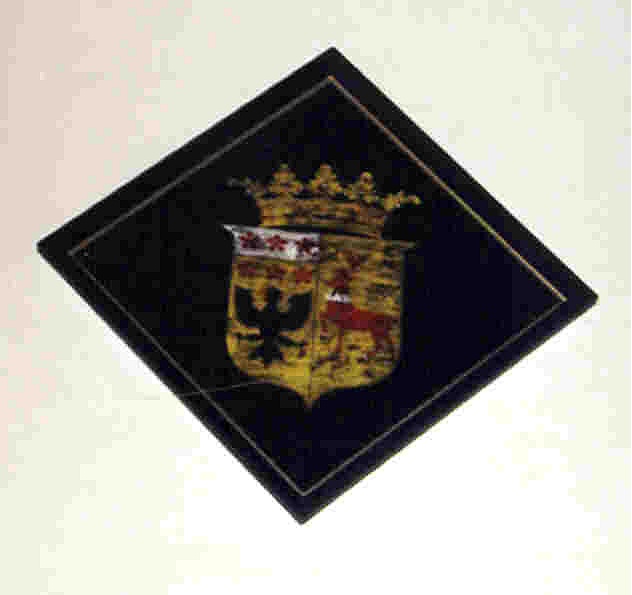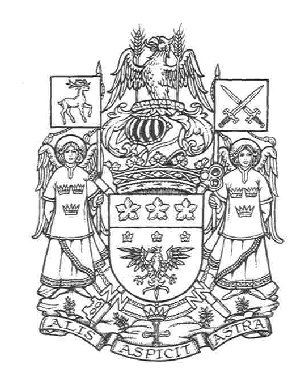| Irish Chiefs Back to Homepage |
Report on the Pedigree and Arms of John Andrew Davison, Styled the Count of Clandermond
As the cracks began to show in 1999 in the hoax kingdom created by Terence MacCarthy, the now discredited and 'abdicated' MacCarthy Mór, Prince of Desmond, there was also in circulation an unsigned report concerning a close associate of his. This was his partner and 'Chamberlain', John Andrew Davison, more usually Andrew Davison, who went by the style 'Count of Clandermond'. While the unattributed nature of this report troubled the present writer, nonetheless upon checking its details, he found it to be quite reliable and well documented (Anonymous, 'Andrew Davison, alias The Count of Clandermond', undated). The report revealed the unpleasant but not entirely irrelevant fact that Davison had been imprisoned for blackmail in Northern Ireland in 1986, and went on to demolish his pretensions to aristocratic descent.
MacCarthy and Davison claimed to be 'cousins', and specifically that Davison's great-great grandfather, Daniel, Count of Clandermond, had married Isabella, daughter of MacCarthy's great-great-great grandfather, Daniel, Lord of Cappagh (Commentary to Samuel Trant MacCarthy Mór, The MacCarthys of Munster, Facsimile Edition, Gryfons Publishers, Little Rock, Arkansas, 1997, pages 522-23). Needless to say, Andrew Davison's aristocratic pedigree was just as spurious as that of Terence MacCarthy, and like his friend, he was Belfast-born and descended from plain folk, his father being a joiner and his great-great grandfather Daniel a labourer (birth, marriage and death registrations, General Register Offices Belfast and Dublin). In one of the more bizarre sideshows of the whole affair, Davison somehow persuaded the Church of Ireland Cathedral in Cashel, County Tipperary, to display an alleged 'funeral hatchment' commemorating the death in 1878 of his 'titled' great-great grandfather Daniel, which had allegedly been transferred from St Patrick's Church, Broughshane, County Antrim. Of course this 'hatchment' has now been removed, together with a plaque commemorating the 'royal ancestry' of Terence MacCarthy.

Clandermond 'Hatchment' in Cashel Cathedral (now removed)
In the course of his extensive checking of records relating to Chiefly irregularites, the writer noted that the then Chief Herald Donal Begley had in fact issued both a grant of arms to Davison in 1985 and a confirmation of arms in 1989. It should be explained that Irish heraldic practice provides not only for the granting of new arms, but alternatively for the confirmation of older arms where evidence can be provided that they have been used by a family for a number of generations. The writer drew the apparent anomaly of dual Davison arms to the attention of the Chief Herald on 22 October 1999, but received no response. The blazon of the 1985 grant of new arms read, 'Azure, a stag trippant argent attired and unguled, gorged with a ducal coronet and chained between the legs or'. The blazon of the 1989 confirmation of supposedly ancient arms read, 'Or, an eagle displayed sable, armed gules, in chief three cinquefoils of the last, on a chief argent three cinquefoils gules'. Davison appears at one stage to have displayed a quartered or combined version of the two arms, but in 1998 he was employing the allegedly ancient form in the following rather fantastical manner:

Preoccupied as he was with his voluntary work relating to the MacCarthy Mór and other bogus Chiefships, the writer did not pursue the matter of the dual Davison arms with the Chief Herald, until in December 2000 he noted a passing reference in an Irish Times magazine article quoting the Chief Herald as stating that 'Davison's grants of arms have been annulled'. Of course the Office of the Chief Herald should properly have notified the writer of this decision when made, but as on so many other occasions, a Freedom of Information application was necessary in order to discover the full facts.
Documents just recently released as a result of this application indicate that the matter of the dual Davison arms was under active consideration in the Office of the Chief Herald/former Genealogical Office from at least August 1999. While the matter could not have entirely escaped the Office's attention beforehand, it would appear that receipt of the above mentioned anonymous report, and indeed the writer's enquiry, rendered some form of action unavoidable. The Office found itself in difficulties investigating the case because of gaps in the documentation, for example, 'the lack of any formal application for the 1989 arms, and the lack of any document in which the applicant formally claims the ancestry set out in the 1989 Letters Patent'. In this connection, it is interesting to note that Davison himself claimed that the 1989 arms had been been awarded 'for services to the Genealogical Office', suggesting that this was yet another of the many strange transactions taking place in the Office of the Chief Herald during this period.
After some deliberation with the Deputy Chief Herald and other staff, the Chief Herald sent a letter to Davison in Morocco on 10 March 2000, drawing to his attention the fact that in accordance with 'universal' heraldic practice, the 1985 grant of arms had automatically been cancelled by the 1989 confirmation. The Chief Herald also observed to Davison that although the confirmation included a pedigree going back to the seventeenth century, no documentary evidence had been provided in support of this, and furthermore, that no historical evidence could be found to support such a title as Count of Clandermond. Davison never responded to this letter, and it is not clear if in fact he received it, as efforts to contact him were unsuccessful. On 12 September 2000, Chief Herald O Donoghue decided to cancel both the 1985 grant and the 1989 confirmation, 'on the basis that they were based on inadequate evidence and documentation', the Office's records being amended accordingly.
Alas, this decision seems rather too pat and convenient. The question immediately arises, how appropriate is it to declare one set of arms cancelled by a later set, and then declare the later set themselves cancelled because of inadequate documentation? Common sense, and no doubt due legal process, indicate that if the 1989 confirmation was not properly made then it should be nullified, but that if no specific fault can be found with the 1985 grant then, however regrettable it might be, it must be allowed to stand. The bogus Clandermond title and the unsupported pedigree may undermine the 1989 confirmation, but they do not appear to have any direct bearing on the 1985 grant of arms. While connotations of gentility are suggested, titles and aristocratic breeding can have no formal part to play in the issuing of arms in a Republic, and indeed the Office of the Chief Herald effectively sells arms in what is a purely commercial transaction. But surely such legal niceties as those outlined need not apply in the case of frauds and fantasists? Due process applies to all, of course, and the fact that irregularites within the Office of the Chief Herald are also involved makes it imperative that the case of the Davison arms should be re-examined by impartial and competent persons.
Taken in isolation, the Davison case might be regarded as an aberrant departure from normally high standards, but considered in the context of a stream of irregularities in the Office of the Chief Herald, including MacCarthy Mór, Maguire of Fermanagh, O Long of Garranelongy, the Braganza grants, and so on, it is much more serious. Once more there are unexplained gaps in the official records, and it is reasonable to ask whether documents might have been removed at any stage. While the issuing of both a grant and a confirmation of arms to Andrew Davison was an irregular duplication, we have raised questions about the manner in which the Chief Herald simply cancelled both. Again, the writer calls for the establishment of an independent public enquiry into the administration of the Office of the Chief Herald and a thorough audit of its records to ensure that all fabricated pedigrees, arms and titles are identified and cleansed therefrom.